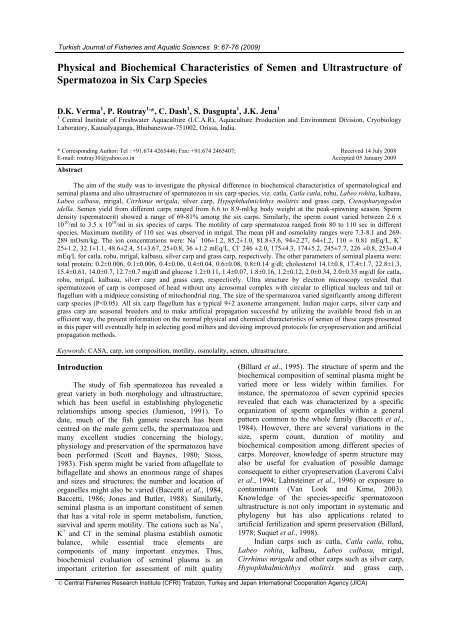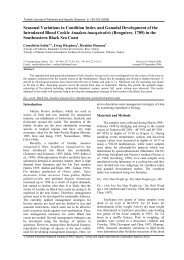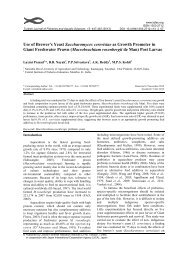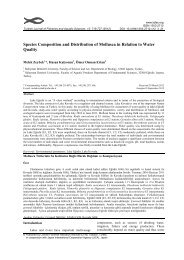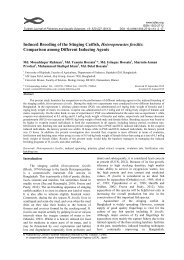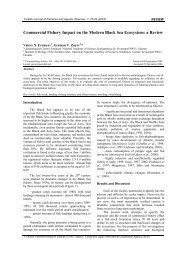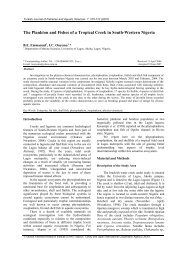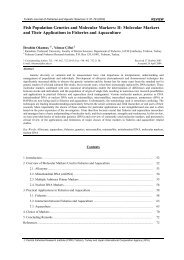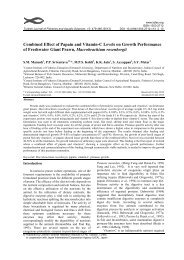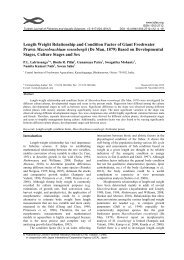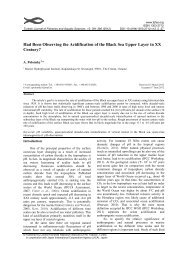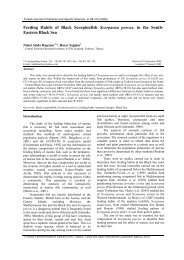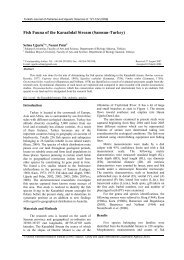Physical and Biochemical Characteristics of Semen and ...
Physical and Biochemical Characteristics of Semen and ...
Physical and Biochemical Characteristics of Semen and ...
Create successful ePaper yourself
Turn your PDF publications into a flip-book with our unique Google optimized e-Paper software.
D.K. Verma et al. / Turk. J. Fish. Aquat. Sci. 9: 67-76 (2009) 69spermatozoa /ml. The osmolality <strong>of</strong> seminal plasmawas measured simultaneously in an osmometer(Model 3250, Advanced Instruments Inc,Massachusetts-02062, USA) <strong>and</strong> expressed asmOsmol /kg.<strong>Biochemical</strong> Analysis <strong>of</strong> Seminal PlasmaMilt from each sample was centrifuged (10,000x g, 10 min) <strong>and</strong> the seminal plasma was removed <strong>and</strong>kept at -20°C for further analysis in the laboratory <strong>of</strong>Biochemistry at the S.C.B. Medical College <strong>and</strong>Hospital, Cuttack, India. All electrolytes, metabolites<strong>and</strong> enzymes were determined using an automatedsystem with adequate st<strong>and</strong>ards (Flexor-XL ISE,Netherl<strong>and</strong>s). The following parameters weremeasured <strong>and</strong> expressed in the following units:albumin (g/dl), glucose (mg/dl) (Srikanth et al.,2004), urea, uric acid (Fei et al., 2006), cholesterol,triglycerides (Sullivan et al., 1985), bilirubin, urea,creatinine (mg/dl) alanine aminotransferase (ALP orGPT), aspartate aminotransferase (AST or GOT),alkaline phosphatase (U/l), chloride, potassium,sodium (mEq/l) (Ng et al., 1985), albumin <strong>and</strong> totalprotein (g/dl) (Kinsgsley, 1939). Alanineaminotransferase <strong>and</strong> aspartate aminotransferase weremeasured by following modified IFCC method(without pyridoxal phosphate) (Henderson <strong>and</strong>Donald, 2001) <strong>and</strong> kinetic colorimetry using p-nitrophenylphosphate (modified IFCC) method,respectively.Sperm UltrastructureThe semen from six species <strong>of</strong> carps wascollected as described earlier for study <strong>of</strong>ultrastructual morphology by scanning electronmicroscope (SEM) <strong>and</strong> transmission electronmicroscope (TEM). A fixation technique fortransmission microscopy was done as used byLahnsteiner <strong>and</strong> Patzner (1991). For TEM, semensamples were fixed in modified Karnovsky’s fluid(0.2 M phosphate or cacodylate Buffer 500 ml <strong>and</strong>Paraformaldehyde 40 g in 960 ml double distilledwater <strong>and</strong> 40 ml <strong>of</strong> 25% glutaraldehyde) (David et al.,1973) buffered with 0.1 M sodium phosphate buffersat pH 7.4. Fixation was for 10-18 h at 4°Ctemperature, after which the tissues were washed infresh buffer <strong>and</strong> post fixed for two hours in 1%osmium tetraoxide in the same buffer at 4°C. Afterseveral washes in 0.1 M Sodium phosphate buffer, thespecimens were dehydrated in graded acetonesolutions <strong>and</strong> embedded in CY 21 araldite. Ultrathinsections <strong>of</strong> 60-80 nm thickness were cut using anultracut E (Reichert Jung) ultra-microtome <strong>and</strong> thesections were stained in 2% alcoholic uranyl acetate(10 min) <strong>and</strong> lead citrate (10 min) before examiningthe grids in a transmission electron microscope(Philips, CM-10) operated at 60-80 KV.The SEM fixation was done as described byMarquez <strong>and</strong> Ogasawara (1975). Milt smears werefixed in modified Karnovsky’s fluid buffered with 0.1M sodium phosphate buffer at pH 7.4. Fixation wasfor 3 h at 4°C temperature, after which the samplewas washed with fresh buffer <strong>and</strong> washed three timesin double distilled water for 15 min each. The samplewas air dried <strong>and</strong> coated with 20nm gold palladium(SEM Leo 435 UP) in a sputter coater <strong>and</strong> observedunder a SEM (Morgangi-268 D) at 80 KV.Statistical AnalysisThe data for semen parameters were analyzedfor each characteristic using triplicate samples takenfrom 6 different species (n=30 for each species).Statistical evaluation was performed by Duncan’smultiple range test (DMRT). A P value <strong>of</strong> P
70 D.K. Verma et al. / Turk. J. Fish. Aquat. Sci. 9: 67-76 (2009)Table 1. <strong>Semen</strong> characteristics <strong>of</strong> six carp speciesParameters Catla Rohu Mrigal Kalbasu Silver carp Grass carpMean semen yield (ml/kg 7.3±0.3 a 8.3±0.9 a 8.9±0.7 a 6.6±2.1 b 6.9±0.4 b 7.1±2 abody weightSpermatocrit (%) 72±3.2 b 67±3.5a 81±2.8 a 80±2.6 a 69±1.5 b 72±1.8 bSperm count (x 10 10 /ml) 2.8±0.19 b 2.71±0.7 b 3.2±0.2 a 3.5±0.3 a 2.6±0.2 b 3±0.2 bMotility (%) 90±1.5 a 90±2.3 a 92±1.4 a 88±3 a 93±1.7 a 89±3.2 aMaximum duration <strong>of</strong> 80±4.5 d 90±5.5 c 110±5.0 a 100±5.5 b 75±3.5 d 85±2.5 dmotility (seconds)<strong>Semen</strong> pH 7.8±0.07 b 7.3±0.06 c 7.9±0.05 b 8.1±0.09 a 7.8±0.03 b 7.9±0.06 bSeminal plasma osmolality 278±7.0 c 269±5.5 d 284±7.5 a 289±8.0 a 276±4.3 c 269±1.8 d(mOsm/kg)Data are expressed as mean±SEM. (n=9).Values having different letters differ significantly in a row (P
D.K. Verma et al. / Turk. J. Fish. Aquat. Sci. 9: 67-76 (2009) 71Table 2. <strong>Biochemical</strong> characteristics <strong>of</strong> seminal plasma <strong>of</strong> carpsParametersCatla(Mean±SEM)Rohu(Mean±SEM)Mrigal(Mean±SEM)Kalbasu(Mean±SEM)Silver carp(Mean±SEM)Grass carp(Mean±SEM)Albumin (g/dl) 0.1±0.006 b 0.1±0.02 b 0.2±0.02 a 0.11±0.02 b 0.13±0.08 b 0.19±0.01 cProtein (g/dl) 0.2±0.006 d 0.1±0.006 d 0.4±0.06 d 0.4±0.04 c 0.6±0.08 b 0.8±0.14 aGlucose (mg/dl) 1.2±0.11 b 1.4±0.07 b 1.8±0.16 c 1.2±0.12 b 2.0±0.34 a 2.0±0.35 aUrea (mg/dl) 1.0±0.12 c 2.7±0.25 b 3.4±0.37 b 3.0±0.39 b 3.0±0.06 b 5.0±1.03 aCreatinine (mg/dl) 0.6±0.04 d 0.42±0.03 d 1.34±0.23 b 2.2±0.29 a 1.1±0.02 c 1.3±0.12 cTotal bilirubin (mg/dl) 0.2±1.08 b 0.09±0.01 b 0.2±0.04 b 0.2±0.02 b 0.1±0.81 b 0.1±0.5 aCholesterol (mg/dl) 14.1±0.8 c 17.4±1.7 b 22.8±1.3 a 15.4±0.61 b 14.0±0.7 c 12.7±0.7 cHDL-Cholesterol 6.0±1.08 c 8.2±1.3 c 7.0±1.2 a 4.0±0.40 c 5.0±1.2 c 4.0±0.3 c(mg/dl)Triglycerides (mg/dl) 3.0±0.4 d 11.7±1.1 c 19.4±0.1 c 15.0±1.22 b 18±0.2 b 39±2.44 aAcid uric (mg/dl) 0.1±0.006 b 0.1±0.007 b 0.4±2.27 b 1.0±0.10 a 1.0±1.6 a 1.0±0.3 aSodium (mEq/L) 106±1.2 a 85.2±1.0 c 81.8±3.6 a 94±2.27 b 64±1.2 d 110±0.81 aPotassium (mEq/L) 25±1.2 b 32.1±1.1 b 48.6±2.4 a 51±3.67 a 25±0.8 b 36±1.2 bChloride (mEq/L) 246±2.0 b 175±4.3 d 174±5.2 d 245±7.7 b 226±0.8 c 253±0.4 aGOT (U/I) 12±1.6 c 23±1.5 a 21±1.18 a 15.9±7.6 b 21±1.6 a 11±1.22 cGPT (U/I) 9±2.2 a 4.2±2 d 2.4±0.2 c 8.0±0.4 a 4.0±0.7 d 7.0±0.81 cData are expressed as mean±SEM. Values having different letters differ significantly in a row (P
72 D.K. Verma et al. / Turk. J. Fish. Aquat. Sci. 9: 67-76 (2009)nenenn1µmAm1µmBnenmnen1µmC1µmDnenenn1µmEFigure 3. Transmission electron micrographs <strong>of</strong> head <strong>of</strong> the mature spermatozoon <strong>of</strong> carps. A: Catla, B: Rohu, C:Mrigal, D: Kalbasu, E: Silver carp, F: Grass carp. n: nucleus, ne: nuclear envelope, m: mitochondria.1µmFFhpmnumdcpcnupmdcmipcffmiABFigure 4. Transmission electron micrograph <strong>of</strong> a spermatozoon <strong>of</strong> (A) mrigal <strong>and</strong> (B) Rohu; h: head, m: midpiece, f:flagellum, pc: proximal centriole, dc: distal centriole, nu: nucleus, pm: plasma membrane, mi: mitochondria.consists <strong>of</strong> a mitochondrial ring <strong>and</strong> centrioles (Figure4). An axoneme with the typical pattern <strong>of</strong> two centralmicrotubules surrounded by a ring <strong>of</strong> nine doubletsoriginated from basal body <strong>of</strong> the distal centriole <strong>and</strong>pervaded the mid-piece (Figure 5). This pattern wasfound in all the six carps. The mean length <strong>of</strong> spermhead <strong>and</strong> flagellum for catla, rohu, mrigal, kalbasu,silver carp <strong>and</strong> grass carp is shown in Table 3. A longflagellum was noticed in case <strong>of</strong> grass carp <strong>and</strong> silvercarp.DiscussionIt is well known that the amount <strong>of</strong> miltproduced from a fish is <strong>of</strong> vital importance infertilization process, as large amount <strong>of</strong> spermatozoa
D.K. Verma et al. / Turk. J. Fish. Aquat. Sci. 9: 67-76 (2009) 73CPMPMRSPDFigure 5. Ultrastructure <strong>of</strong> the flagellum <strong>of</strong> Indian major carp with a schematic representation <strong>of</strong> the inner structure showingthe 9+2 arrangement; CPM: central microtubule, PM: plasma membrane, RS: radial spokes, PD: peripheral doublets.gets wasted due to several problems associated withthe external environment <strong>and</strong> short motility time <strong>of</strong>spermatozoa. Similarly, the semen characteristic alsovaries from species to species. These parameters areimportant for devising various breeding <strong>and</strong>cryopreservation protocols <strong>of</strong> fish spermatozoa(Routray et al., 2006; Routray et al., 2007). In thepresent study, we assessed the semen characteristics<strong>and</strong> ultrastructure <strong>of</strong> six important carp species forgenerating an information database for future researchin the carp gamete research. The variation in thesemen yield from different carps was evident due tothe individual characteristics <strong>of</strong> species. However, inany case the semen yield from these carps was notless than 6 ml per kg body weight. The semen yieldfrom jundiá, Rhamdia quelen has been reported to bein the range <strong>of</strong> 0.24 to 0.95 ml per kg body weight(Borges et al., 2005). Similarly, semen yield fromLabeo rohita injected with pituitary gl<strong>and</strong> extract hasbeen reported to be 3.63-ml/kg body weight (Khan etal., 1992). In the present study, all the species wereinjected with synthetic GnRH + Dopamine antogonisthormone (Ovaprim) that has resulted in better semenoutput from carps.A wide variation in the sperm density(spermatocrit) <strong>and</strong> sperm count was noticed amongthe different carp species. These variations are due tothe spermatozoa size <strong>and</strong> species-specific nature <strong>of</strong>carps. Significant correlation between spermatozoadensity <strong>and</strong> spermatocrit was reported in rainbowtrout (Baynes <strong>and</strong> Scott, 1985) <strong>and</strong> for several otherteleost species (Bouck <strong>and</strong> Jacobson, 1976; Piironen,1985; Ciereszko <strong>and</strong> Dabrowski, 1993; Ratikin et al.,1999; Tvedt et al., 2001). The present study alsoshowed a trend that the higher the sperm count themore was the spermatocrit value in carps <strong>and</strong>recommends using spermatocrit value as a method <strong>of</strong>determining the sperm density. In Labeo rohitaspermatocrit value <strong>of</strong> more than 70% is generallyrecommended for utilization in cryopreservation <strong>and</strong>fertilization process (Routray et al., 2006).The motility <strong>of</strong> spermatozoa upon activation wasmore than 90% in carps <strong>and</strong> the motility remains for75 to 110 sec. After this time, most <strong>of</strong> thespermatozoa becomes immobile. The duration <strong>of</strong>spermatozoa motility <strong>of</strong> several cyprinids is till 120seconds (Suzuki, 1959). Similarly, here in case <strong>of</strong>Indian major carps, silver carp <strong>and</strong> grass carp, it wasobserved till 110 sec. The different types <strong>of</strong> motilityexhibited by carp spermatozoa have been enumeratedby CASA. The most obvious parameters that areuseful in assessing sperm quality are motility,progressive motility <strong>and</strong> duration <strong>of</strong> movement. Inmammals, the straight line velocity (VSL) i.e., theprogressive velocity in a specific direction <strong>of</strong> sperm isthe most reliable indicator <strong>of</strong> fertility (Moore <strong>and</strong>Akhondi, 1996). In fish, the trajectory was generallymore curved than mammals <strong>and</strong> fish sperm can movethree dimensionally in the aqueous medium, so theduration <strong>of</strong> progressive movement decreases rapidly.This is an important factor for the sperm ability toenter the egg. Here, the progressive motility was morethan 60% in spermatozoa <strong>of</strong> Indian major carps aswell as in silver <strong>and</strong> grass carps. Carp spermatozoa inthis study exhibited mostly four motility patterns;namely, progressive, VSl, VCL <strong>and</strong> linear <strong>and</strong> somespermatozoa also showed haphazard movement. Themotility pattern <strong>and</strong> duration <strong>of</strong> motility demonstratedpronounced time dependent motility after activation.This study provides a first h<strong>and</strong> report about themotility patterns <strong>of</strong> spermatozoa <strong>of</strong> six species <strong>of</strong>carps. Motility patterns <strong>of</strong> carp spermatozoa followingshort-term storage <strong>of</strong> semen demonstrated a timedependent decrease in VCL, VAP, VSL <strong>and</strong> ALHfollowing activation with water (Ravinder et al.,1997). The CASA system is a useful tool to achievereliable results to analyze sperm quality; because ittakes several images <strong>of</strong> sperm samples <strong>and</strong> using an
74 D.K. Verma et al. / Turk. J. Fish. Aquat. Sci. 9: 67-76 (2009)automatic process, analyzes the motility parametersthat are essential to determine the quality <strong>of</strong> thestudied sperm.Moreover, studies focused on the biochemicalcomposition <strong>of</strong> seminal plasma <strong>of</strong> carps speciesduring the spawning season are scarce or limited.Billard et al. (1995) have reviewed the biochemicalcomposition <strong>of</strong> seminal plasma <strong>of</strong> some fish. Thesodium <strong>and</strong> potassium levels in the seminal plasma <strong>of</strong>six carps were high as shown in Table 2 <strong>and</strong> mostprobably responsible for the suppression <strong>of</strong> spermmotility due to their osmotic effect. The Na + <strong>and</strong> K +levels are known to suppress the sperm motility injundiá, Rhamdia quelen (Borges et al., 2005; Billard,1975; Benau <strong>and</strong> Terner, 1980; Morisawa, 1985).When the seminal plasma ionic composition wascompared with the data reported by the review <strong>of</strong>Linhart et al. (1991) on four salmonid species(Oncorhynchus mykiss, O. keta, Salmo salar, Salmoclarki) <strong>and</strong> four cyprinid species (Cyprinus carpio,Vimba vimba, Ctenopharyngodon idella, Stizostediumvitreum), it was found that the Na + <strong>and</strong> K + levels werecomparable to our studies. The seminal plasmaosmolality plays an important role in spermatozoaactivation. The osmolality <strong>of</strong> seminal plasma wasused as a controlling point to develop extenders forsemen <strong>of</strong> many fish species <strong>and</strong> reversibly suppressesthe spermatozoa activation (Ohta <strong>and</strong> Izawa, 1996).Osmolality <strong>of</strong> any extenders used for artificialpropagation <strong>of</strong> fish seminal plasma is generallyadjusted by the use <strong>of</strong> Na + <strong>and</strong> K + levels. Spermquiescence in undiluted semen occurs roughly in therange <strong>of</strong> 270-300 mOsm/kg. The seminal plasmaosmolality in the European eel has been reported to bein the range <strong>of</strong> 325-330 mOsm/kg <strong>and</strong> extenders withthis range <strong>of</strong> values helped in reversibly suppressingthe motility <strong>of</strong> spermatozoa (Asturiano et al., 2004).The glucose content <strong>of</strong> seminal plasma is also animportant biochemical parameter; because it providesmembrane protection to spermatozoa <strong>and</strong> serves as anexternal cryoprotectant as well (Maisse, 1996). Sugarextenders are also used successfully in Africancatfish, Clarias gariepinus (Steyn <strong>and</strong> Van Vuren,1987; Urbányi et al., 1999). The present study hasestimated the glucose level in seminal plasma <strong>of</strong> sixspecies <strong>of</strong> carps that may be used for future referencewhile preparing extenders for carps.Ultrastructural studies <strong>of</strong> spermatozoa <strong>of</strong> Indianmajor carps, silver carp <strong>and</strong> grass carp were notreported earlier. The morphological structureexhibited by sperms <strong>of</strong> these carps described hereshow similarity to those described in most <strong>of</strong> theteleostean fishes in which the absence <strong>of</strong> acrosome isa common character (Mattei, 1970). A variety <strong>of</strong>acrosomal structures are found in fish spermatozoa(Stanley, 1971; Mattei, 1970); however, carpspermatozoa lacked an acrosome. The acrosomereaction occurs inside or on the surface <strong>of</strong> the eggenvelope to allow sperm penetration. In case <strong>of</strong>teleostean fish such as carps, spermatozoa reach theegg plasma membrane through a narrow micropylebecause the sperm lacks an acrosome (Morisawa,1995). The sperm has a slightly elliptical nucleusalways eccentrically placed on the tail; two variouslyoriented centrioles <strong>and</strong> post nuclear cytoplasmicregion <strong>of</strong> varying size which contains themitochondrion <strong>and</strong> surrounds the periaxonemal postnuclear canal (Jamieson, 1991).To date all the fish spermatozoa examined showsome structural homogeneity which supports the ideathat the ultrastructural features <strong>of</strong> spermatozoon canbe useful for taxonomic <strong>and</strong> phylogenetic studies(Baccetti et al., 1984; Mattei <strong>and</strong> Mattei, 1984; Gwoet al., 1996). Spermatozoa <strong>of</strong> species that exhibitexternal fertilization, including the Indian major carpsusually have a few mitochondria in the short midpiece surrounding the centrioles <strong>and</strong> the 9+2 axonemewithout accessory structures in the flagellum. Thestructure <strong>of</strong> carp flagellum is highly conserved in theteleostean group <strong>and</strong> is composed <strong>of</strong> a number <strong>of</strong>cytoskeletal elements whose proper assembly iscritical for sperm motility. The axoneme is acytoskeletal structure composed <strong>of</strong> a ring <strong>of</strong> 9microtubule doublets surrounding a central pair. Theflagellum <strong>of</strong> spermatozoa <strong>of</strong> Indian major carps aswell as that <strong>of</strong> silver <strong>and</strong> grass carp wascomparatively longer (13-24 µm in length) whencompared to their body size. This could be probablycountered the vagaries <strong>of</strong> nature. In aquatic specieswith external fertilization the spermatozoa arereleased into a hostile environment where theytypically become activated, then survive for a shortperiod <strong>of</strong> 1-2 min in case <strong>of</strong> freshwater fish (Holt <strong>and</strong>van Look, 2004). The duration <strong>of</strong> carp spermatozoamotility in the present study also observed a durationfrom 1-3 min after activation with water.Indian major carps, silver carp <strong>and</strong> grass carp areseasonal breeders <strong>and</strong> to make artificial propagationsuccessful by utilizing the available brood fish in anefficient way, the present information <strong>of</strong> the normalphysical <strong>and</strong> chemical characteristics <strong>of</strong> semen <strong>of</strong>these carps presented here will eventually help inselecting good milters <strong>and</strong> devising improvedprotocols for cryopreservation <strong>and</strong> artificialpropagation methods.AcknowledgementsThe authors are thankful to Indian Council <strong>of</strong>Agricultural Research, New Delhi for providingfinancial support for undertaking the present work inthe form <strong>of</strong> an Institute based project <strong>and</strong> a doctoralfellowship to D. K. Verma.ReferencesAsturiano, J.F., Pérez, L., Garzón, D.L., Marco-Jiménez, F.,Peñar<strong>and</strong>a, D.S., Vicente, J.S. <strong>and</strong> Jover, M. 2004.Physio-chemical characteristics <strong>of</strong> seminal plasma <strong>and</strong>development <strong>of</strong> media <strong>and</strong> methods for thecryopreservation <strong>of</strong> European eel sperm. Fish.Physiol. Biochem., 30: 283-293.
D.K. Verma et al. / Turk. J. Fish. Aquat. Sci. 9: 67-76 (2009) 75Baccetti, B. 1986. Evolutionary trends in sperm structure.Comp. Biochem. Physiol., 85: 29-36.Baccetti, B., Burrini, A.G., Callaini, G., Gilbertini, G.,Mazzini, M. <strong>and</strong> Zerunian, S. 1984. Fish germinalcells. I. Comparative spermatology <strong>of</strong> seven cyprinidspecies. Gamete Research, 10: 373-396.Baynes, S.M. <strong>and</strong> Scott, A.P. 1985. Seasonal variation inparameters <strong>of</strong> milt production <strong>and</strong> plasmaconcentration <strong>of</strong> sex steroid in male rainbow trout(Salmo gairdneri). Gen. Comp. Endocrinol., 57: 150-160.Benau, D. <strong>and</strong> Terner, C. 1980. Initiation prolongation <strong>and</strong>reactivation <strong>of</strong> the motility <strong>of</strong> salmonid spermatozoa.Gamete Res., 3: 247-257.Billard, R. 1975. L’insemination artificicielle de la truiteSalmo gairdneri Richardson. IV. Effets des ions K + etNa + sur la conservation du pouvoir fecondant desgametes. Bull. Fr. Piscic., 256: 88-98.Billard, R. 1978. Changes in structure <strong>and</strong> fertilizing ability<strong>of</strong> marine <strong>and</strong> freshwater fish spermatozoa diluted inmedia <strong>of</strong> various salinities. Aquaculture, 14: 187-198.Billard, R., Cosson, J., Perchec, G. <strong>and</strong> Linhart, O. 1995.Biology <strong>of</strong> sperm <strong>and</strong> artificial reproduction in carp.Aquaculture, 129: 95-112.Borges, A., Siqueira, D.R., Jurinitz, F., Zanini, R., Amaral,F. do, Grillo, M.L., Oberst, E.R. <strong>and</strong> Wassermann,G.F. 2005. <strong>Biochemical</strong> composition <strong>of</strong> seminalplasma <strong>and</strong> annual variations in semen characteristics<strong>of</strong> jundia Rhamdia quelen (Quoy <strong>and</strong> Gaimard,Pimelodidae). Fish Physiol Biochem, 31: 45-53.Bouck, G.R. <strong>and</strong> Jacobson, J. 1976. Estimation <strong>of</strong> salmonidsperm concentration by microhaematocrit technique.Tras. Am. Fish. Soc., 105: 534-535.Bromage, N.R. 1995. Broodstock management <strong>and</strong> seedquality, general consideration In: N.R. Bromage <strong>and</strong>R.J. Robert (Eds.), Broodstock Management <strong>and</strong> Egg<strong>and</strong> Larval Quality. Blackwell, Oxford: 1-24.Ciereszko, A. <strong>and</strong> Dabrowski, K. 1993. Estimation <strong>of</strong> spermconcentration <strong>of</strong> rainbow trout, whitefish <strong>and</strong> yellowperch using a spectrophotometric technique.Aquaculture, 109: 367-373.David, G.F.X., Herbert, J. <strong>and</strong> Wright, C.D.S. 1973. Theultrastructure <strong>of</strong> the pineal ganglion in the ferret. J.Anat., 115: 79-97.Fei, L., Yun-Sheng, Z., Li-na, Z, Jia, T., Xiao-yun, Z. <strong>and</strong>Lan, L. 2006. Evaluation <strong>of</strong> a kinetic uricase methodfor serum uric acid assay by predicting backgroundabsorbance <strong>of</strong> uricase reaction solution with anintegrated method. J. Zhezian Univ. Sci., 7(6): 497-502.Gwo, J.C., Lin, X.W., Gwo, H.H., Wu, H.C. <strong>and</strong> Lin, P.W.1996. The ultrastructure <strong>of</strong> Formosan l<strong>and</strong>lockedsalmon, Oncorhynchus masou formosanus,spermatozoon. (Teleostei: Salmoniformes,Salmonidae). J. Submicrosc. Cytol. Pathl., 28: 33-40.Gupta, S.D., Rath, S.C. <strong>and</strong> Dasgupta, S. 1995. Fertilizationefficiency <strong>of</strong> cryopreserved carp spermatozoa overfour years at different time intervals after thawing.Geobios, 22: 208–211.Henderson, A.R. <strong>and</strong> Donald, W.M. 2001. Enzymes. In:C.A. Burtis, E.R. Ashwood, W.B. Saunders (Eds.),Tietz Fundamentals <strong>of</strong> Clinical Chemistry, 5 th Ed.Philadelphia, USA, 352 pp.Holt, W.V. <strong>and</strong> van Look, K.J.W. 2004. Concepts in spermheterogeneity, sperm selection <strong>and</strong> sperm competitionas biological foundations for laboratory tests <strong>of</strong> semenquality. Reproduction, 127: 527-535.Jamieson, B.G.M. 1991. Fish evolution <strong>and</strong> systematic:Evidence from spermatozoa. Cambridge UniversityPress. Cambridge, 319 pp.Jones, P.R. <strong>and</strong> Butler, R.D. 1988. Spermatozoonultrastructure <strong>of</strong> Platichthys flesus. J. Ultrastruct. Mol.Struct. Res., 98: 71-82.Khan, H.A., Gupta, S.D. <strong>and</strong> Tantia, M.S. 1992. A newmethod to induce spermiation, ovulation byhypophysation in the Indian major carp Labeo rohita.J Aqua Trop., 7: 143-150.Kingsley, G.R. 1939. The determination <strong>of</strong> serum totalprotein, albumin <strong>and</strong> globulin by the biuret reaction. J.Biol. Chem., 197-200.Lahnsteiner, F. <strong>and</strong> Patzner, R.A. 1991. A new method forelectron microscopial fixation <strong>of</strong> spermatozoa <strong>of</strong>freshwater teleosts. Aquaculture, 97: 301-304.Lahnsteiner, F., Berger, B., Weismann, T. <strong>and</strong> Patzner, R.1996. Changes in morphology, metabolism <strong>and</strong>fertilization capacity <strong>of</strong> rainbow trout semenfollowing cryopreservation, Progress. Fish Cult., 58:149-159.Leveroni Calvi, S., Zoccarato, I., Gasco, L. <strong>and</strong> Andriano,A. 1994. Effeto dell aggiunta di treaosio e/o albuminae della concentrazione di mettnolo sulla motilita delseme di carpa (Cyprinus carpio L). Riv. Ital.Aquacol., 29: 45-51.Linhart, O., Slechta, V. <strong>and</strong> Slavic, T. 1991. Fish spermcomposition <strong>and</strong> biochemistry. Bulletin <strong>of</strong> theInstitute <strong>of</strong> Zoology, Academia Sinica. Monograph,16: 285-311.Maisse, G. 1996. Cryopreservation <strong>of</strong> fish semen: a review.Proceedings <strong>of</strong> the Refrigeration Science <strong>and</strong>Technology Conference, Refrigeration <strong>and</strong>Aquaculture. Institut International du Froid, Paris,France: 443-467.Marquez, B.J. <strong>and</strong> Ogasawara, F.X. 1975. Scanning electronmicroscope studies <strong>of</strong> turkey semen. Poultry Sci., 54:1139-1143.Mattei, C. <strong>and</strong> Mattei, X. 1984. Spermatozoides biflagelleschez un poisson teleosteen de la famille desApogonides. J. Ultrastructure Res., 88: 223-228.Mattei, X. 1970. Spermiogenese compare des poisons.Comp. In: B. Baccetti (Eds.), Spermatology.Academic Press. New York: 57-69.Moore, H. <strong>and</strong> Akhondi, M. 1996. Fertilizing capacity <strong>of</strong> ratspermatozoa is correlated with decline in straight linevelocity measured by continuous computer-aidedsperm analysis: Epididymal rat spermatozoa fromproximal cauda have a greater fertilizing capacity invitro than those from the distal cauda or vas deferens.J. Androl., 17: 50-60.Morisawa, M. 1985. Initiation mechanism <strong>of</strong> sperm motilityat spawning in teleosts. Zool. Sci., 2: 605-615.Morisawa, M. 1995. Fine structure <strong>of</strong> spermatozoa <strong>of</strong> theHagfish Eptatreus burgeri (Agnatha). Biol. Bull., 189:6-12.N<strong>and</strong>i, S., Routray, P., Gupta, S.D., Rath, S.C., Dasgupta,S., Meher, P.K. <strong>and</strong> Mukhopadhyay, P.K. 2007.Reproductive performance <strong>of</strong> carp, Catla catla(Ham.), reared on a formulated diet with PUFAsupplementation. J Appl. Ichthyol., 23: 684-691.Ng, R.H., Altaffer, M., Ito, R. <strong>and</strong> Statl<strong>and</strong>, B.E. 1985. Thetechnicon RA-1000 evaluated for measuring sodium,potassium, chloride <strong>and</strong> carbon dioxide. Clin. Chem.,31(3): 435-438.Ohta, H. <strong>and</strong> Izawa, T. 1996. Diluent for cool storage <strong>of</strong> theJapanese eel (Anguilla japonica) spermatozoa.Aquaculture, 142: 107-118.Piironen, J. 1985. Variation in the properties <strong>of</strong> milt from
76 D.K. Verma et al. / Turk. J. Fish. Aquat. Sci. 9: 67-76 (2009)the finfish l<strong>and</strong>locked salmon (Salmo salar m. SebagoGirad) during a spawning season. Aquaculture, 48:337-350.Ratikin, A., Ferguson, M.M. <strong>and</strong> Trippel, E.A. 1999.Spermatocrit <strong>and</strong> spermatozoa density in Atlantic cod(Gadus morhua): correlation <strong>and</strong> variation during thespawning season. Aquaculture, 170: 349-358.Ravinder, K., Nasaruddin, K., Majumdar, K.C. <strong>and</strong> Shivaji,S. 1997. Computerized analysis <strong>of</strong> motility, motilitypatterns <strong>and</strong> motility parameters <strong>of</strong> spermatozoa <strong>of</strong>carp following short term storage <strong>of</strong> semen. J. FishBiol., 50(6): 1309-1328.Routray, P., Choudhary, A.K., Dash, S.N., Verma, D.K.,Dash, C., Swain, P., Jena, J.K., Gupta, S.D. <strong>and</strong>Sarangi, N. 2006. Cryopreservation <strong>of</strong> dead fishspermatozoa several hours after death <strong>of</strong> Indian majorcarp, Labeo rohita <strong>and</strong> its successful utilization in fishproduction. Aquaculture, 261: 1204-1211.Routray, P., Verma, D.K., Sarkar, S.K. <strong>and</strong> Sarangi, N.2007. Recent advances in carp seed production <strong>and</strong>milt cryopreservation. Fish Physiol. Biochem., 33:413-427.Scott, A.P. <strong>and</strong> Baynes, S.M. 1980. A review <strong>of</strong> the biology,h<strong>and</strong>ling <strong>and</strong> storage <strong>of</strong> salmonid spermatozoa,Journal <strong>of</strong> Fish Biology., 17: 707-739.Srikanth, M., Rao, G.V. <strong>and</strong> Rao, K.R.S.S. 2004. Modifiedassay procedure for the estimation <strong>of</strong> serum glucoseusing microwell reader. Ind. J. Clin. Biochem., 19(1)43-35.Stanley, H.P. 1971. Fine structure <strong>of</strong> spermiogenesis in theElasmobranch fish Squalus suckleyi II. Late stages <strong>of</strong>differentiation <strong>and</strong> structure <strong>of</strong> the maturespermatozoan. Journal <strong>of</strong> Ultrastructure Research, 36:103-118.Steyn, G.J. <strong>and</strong> van Vuren, J.H.J. 1987. The fertilizingcapacity <strong>of</strong> cryopreserved sharptooth catfish (Clariasgariepinus) sperm. Aquaculture, 63: 187-193.Stoss, J. 1983. Fish gamete preservation <strong>and</strong> spermatozoanphysiology. In: W.S. Hoar, D.J. R<strong>and</strong>oll <strong>and</strong> E.M.Donaldson (Eds.), Physiology IX B. Academic Press;New York: 305-350.Sullivan, D.R., Kruijswijk, Z., West, C.E., Kohlmeier, M.<strong>and</strong> Katan, M.B. 1985. Determination <strong>of</strong> serumtriglycerides by an accurate enzymatic method notaffected by free glycerol. Clin. Chem., 31(7): 1227-1228.Suquet, M., Dreanno, C., Dorange, G., Normat, Y.,Quemner, L., Gaigon, J.L. <strong>and</strong> Billard, R. 1998. Theaging phenomenon <strong>of</strong> turbot spermatozoa: Effect onmorphology, motility <strong>and</strong> concentration, intracellularATP content, fertilization <strong>and</strong> storage capacities. J.Fish. Biol., 52: 31-41.Suzuki, R. 1959. Sperm activation <strong>and</strong> aggregation duringfertilization in some fishes: III Non species specificity<strong>of</strong> stimulating factor. Annot. Zool. Jap., 32: 105-111.Tvedt, H.B., Benfey, T.J., Martin-Robichaud, D.J. <strong>and</strong>Power, J. 2001. The relationship between spermdensity, spermatocrit, sperm motility <strong>and</strong> fertilizationsuccess in Atlantic halibut, Hipoglossus hippoglossus.Aquaculture, 194: 191-200.Urbányi, B., Horváth, Á., Varga, Z., Horváth, L., Magyary,I. <strong>and</strong> Radics, F. 1999. Effect <strong>of</strong> extenders on spermcryopreservation <strong>of</strong> African catfish, Clariasgariepinus (Burchell, 1822). Aquac. Res., 30: 145-259.Van Look, K.J.W. <strong>and</strong> Kime, D.E. 2003. Automated spermmorphology analysis in fishes: the effect <strong>of</strong> mercuryon goldfish sperm. J. Fish. Biol., 63: 1020-1033.Wedemeyer, G.A. <strong>and</strong> Yasutake, W.T. 1977. Clinicalmethods for the assessment <strong>of</strong> the effects <strong>of</strong>environmental stress on fish health. US Fish Wildl.Ser., Tech. Paper No 89. Washington D.C., 18 pp.


